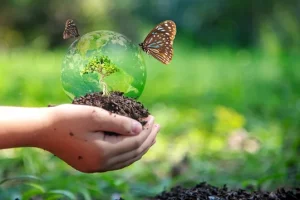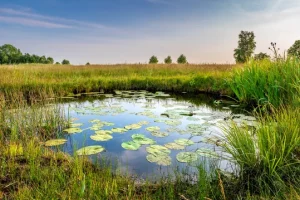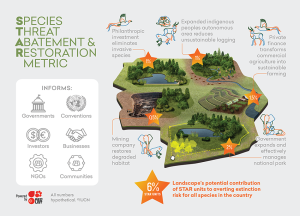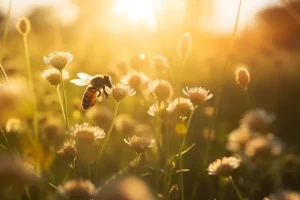Dr. Uttam Saikia underscores the importance and value in conserving biodiversity and its multifaceted impact on our future.
 The World observes International Day for Biological Diversity (or Biodiversity Day in brief) on May 22, a day that reminds us of the fundamental nature of Earth’s biological diversity and the pressing need for their conservation and sustainable use. The day was proclaimed by the United Nations to celebrate the adoption of the initial text of the Convention on Biological diversity in 1992. Although the Day has a relatively recent origin, its reach and significance has been profound since it is intricately related to the Biodiversity Convention. All through these years since the Convention has been in force in 1993, numerous species, habitats and ecosystems are being protected globally to various extents through species recovery programmes and a network of protected areas, thus providing a silver lining in an otherwise gloomy scenario.
The World observes International Day for Biological Diversity (or Biodiversity Day in brief) on May 22, a day that reminds us of the fundamental nature of Earth’s biological diversity and the pressing need for their conservation and sustainable use. The day was proclaimed by the United Nations to celebrate the adoption of the initial text of the Convention on Biological diversity in 1992. Although the Day has a relatively recent origin, its reach and significance has been profound since it is intricately related to the Biodiversity Convention. All through these years since the Convention has been in force in 1993, numerous species, habitats and ecosystems are being protected globally to various extents through species recovery programmes and a network of protected areas, thus providing a silver lining in an otherwise gloomy scenario.
Biodiversity depletion: a human driven phenomenon
 Despite the general understanding that biodiversity is critical to human existence and welfare, we continue to lose biodiversity (species, habitat and genetic variations) at an alarming rate. The UN Food and Agriculture Organization estimates that the average global extent of deforestation in the last decade was about 10 million hectares per year, an area equivalent to a country like Iceland or little larger than the Indian state of Bihar. Plants and animal species continue to face risk of extinction with about 29 percent of the assessed species facing extinction. Ironically, we do not have a very good estimate of the number of plant, animals or microbe species inhabiting this planet. Depending on various estimates, the Earth could be losing as much as 100,000 species per year which translates to a disquieting rate of one in every five minutes! An overwhelming percentage of these losses are occurring in the tropics, the powerhouse of biodiversity. Periodic large scale loss of species is part of the evolutionary history of the planet called mass extinction events and about five such events in the distant past have been recorded by the scientists. They were all driven by natural factors like asteroid impact, rise in sea level, sudden change in climate pattern, volcanic activity. However, the current phenomenon of species loss is entirely driven by human activities like deforestation, overexploitation, pollution, and human mediated climate change. All these causative agents are inexorably linked to the exponential growth of human population and ever increasing demand for resources to sustain this burgeoning population. It is a clear case of one species going rogue due to greater brain development and catapulting into a force capable of tweaking the environment on a massive scale; with disastrous results.
Despite the general understanding that biodiversity is critical to human existence and welfare, we continue to lose biodiversity (species, habitat and genetic variations) at an alarming rate. The UN Food and Agriculture Organization estimates that the average global extent of deforestation in the last decade was about 10 million hectares per year, an area equivalent to a country like Iceland or little larger than the Indian state of Bihar. Plants and animal species continue to face risk of extinction with about 29 percent of the assessed species facing extinction. Ironically, we do not have a very good estimate of the number of plant, animals or microbe species inhabiting this planet. Depending on various estimates, the Earth could be losing as much as 100,000 species per year which translates to a disquieting rate of one in every five minutes! An overwhelming percentage of these losses are occurring in the tropics, the powerhouse of biodiversity. Periodic large scale loss of species is part of the evolutionary history of the planet called mass extinction events and about five such events in the distant past have been recorded by the scientists. They were all driven by natural factors like asteroid impact, rise in sea level, sudden change in climate pattern, volcanic activity. However, the current phenomenon of species loss is entirely driven by human activities like deforestation, overexploitation, pollution, and human mediated climate change. All these causative agents are inexorably linked to the exponential growth of human population and ever increasing demand for resources to sustain this burgeoning population. It is a clear case of one species going rogue due to greater brain development and catapulting into a force capable of tweaking the environment on a massive scale; with disastrous results.
What does loss of biodiversity mean to us?
 It is a no brainer that if the human race has to prosper on this planet, biodiversity loss needs to be halted. The welfare of humans and that of the entire biota is intricately related. The depletion of ecosystem functioning and loss of biodiversity aggravate problems like climate change and is detrimental to the natural processes which protect human health and bring in clean air, water and food. Like all other living creatures on Earth, the basic needs of us are fulfilled by nature. The cultivars producing staple food products like grains, beans, tubers, fruits were all derived from the wild and later domesticated. The primary source of protein like meat and fish are all produced by domesticated stock of wild cousins. Even today, there are numerous species of wild plants and animals that are a significant source of food for indigenous communities across the globe. Many of these species possess some desirable qualities like resistance to disease or drought or producing high content of nutrients. Through selective breeding, it is possible to transfer these useful qualities to domestic varieties that may help develop crops resistant to environmental vagaries or yielding nutrient rich food. In short, biodiversity ensures our food security.
It is a no brainer that if the human race has to prosper on this planet, biodiversity loss needs to be halted. The welfare of humans and that of the entire biota is intricately related. The depletion of ecosystem functioning and loss of biodiversity aggravate problems like climate change and is detrimental to the natural processes which protect human health and bring in clean air, water and food. Like all other living creatures on Earth, the basic needs of us are fulfilled by nature. The cultivars producing staple food products like grains, beans, tubers, fruits were all derived from the wild and later domesticated. The primary source of protein like meat and fish are all produced by domesticated stock of wild cousins. Even today, there are numerous species of wild plants and animals that are a significant source of food for indigenous communities across the globe. Many of these species possess some desirable qualities like resistance to disease or drought or producing high content of nutrients. Through selective breeding, it is possible to transfer these useful qualities to domestic varieties that may help develop crops resistant to environmental vagaries or yielding nutrient rich food. In short, biodiversity ensures our food security.
 The same is true for human health; nature is the world’s original pharmacy. The era of a hallowed group of medicines called antibiotics started with the discovery of the first antibiotic Penicillin in the 1940. It is estimated that over fifty percent of the currently approved drugs to treat human diseases are derived from natural sources. Scientists are increasingly focused towards finding novel molecules with therapeutic potential from natural products, be it a plant extract or microorganisms. In fact, human economics is also intricately intertwined with biodiversity. A case in point is our very own Lakadong Turmeric. This variety of turmeric grown in and around Lakadong village of West Jaintia Hills is known worldwide for its high curcumin content, the main therapeutic chemical in turmeric. Reportedly, the variety has been domesticated by the people of the region for over a century and has the potential to uplift the economy of the region if marketed effectively (See Ray et al, 2023). There is a term called “biodiversity option value”, meaning one never knows which component of biodiversity will be useful in the future. A massive failure of a cash crop due to invading pests or disease can have devastating economic consequences for a region. Similarly, a pandemic like Covid-19 has shown how a sub-microscopic pathogen can bring our life to a grinding halt. Although it is near impossible to predict a random event like pandemic, scientists are already calling for preparedness for a future pandemic including quick development of diagnostic tools and drugs. Who knows, the secrets lying in the womb of Mother Nature can potentially provide a remedy for these future situations. If we have to lose biodiversity, we lose this crucial option value.
The same is true for human health; nature is the world’s original pharmacy. The era of a hallowed group of medicines called antibiotics started with the discovery of the first antibiotic Penicillin in the 1940. It is estimated that over fifty percent of the currently approved drugs to treat human diseases are derived from natural sources. Scientists are increasingly focused towards finding novel molecules with therapeutic potential from natural products, be it a plant extract or microorganisms. In fact, human economics is also intricately intertwined with biodiversity. A case in point is our very own Lakadong Turmeric. This variety of turmeric grown in and around Lakadong village of West Jaintia Hills is known worldwide for its high curcumin content, the main therapeutic chemical in turmeric. Reportedly, the variety has been domesticated by the people of the region for over a century and has the potential to uplift the economy of the region if marketed effectively (See Ray et al, 2023). There is a term called “biodiversity option value”, meaning one never knows which component of biodiversity will be useful in the future. A massive failure of a cash crop due to invading pests or disease can have devastating economic consequences for a region. Similarly, a pandemic like Covid-19 has shown how a sub-microscopic pathogen can bring our life to a grinding halt. Although it is near impossible to predict a random event like pandemic, scientists are already calling for preparedness for a future pandemic including quick development of diagnostic tools and drugs. Who knows, the secrets lying in the womb of Mother Nature can potentially provide a remedy for these future situations. If we have to lose biodiversity, we lose this crucial option value.
A framework for biodiversity conservation
Ever since the term biodiversity was introduced in scientific literature in 1988, it has been at the centre stage of most of the conservation efforts globally. A legal framework like the Biodiversity Convention is at the forefront of all global efforts to protect and to utilise biological resources sustainably and in an equitable manner. The Convention recognises that biodiversity conservation is a common concern for humankind and is an integral part of the developmental process. Towards this end, the Convention mandates the signatory countries to develop Biodiversity Strategy and Action Plan. The main components of such a plan is to prepare inventories of biological systems of selected species and habitat, assessment of conservation status of species in selected ecosystems and creation of targets for conservation and restoration with a set timeline and budget. Some of the signatories to the Biodiversity Convention have developed their country specific Action Plan including India. Needless to say that this action plan forms the key element of any conservation efforts of that country. One of the drawbacks of such a plan has been that it mostly concerns the higher plants and vertebrate groups, the lower plants, animals and microorganisms are hardly taken into account i.e. it is more wildlife centric. It is important to understand that the terms ‘wildlife’ and ‘biodiversity’ are very different, the latter is a very inclusive term encompassing every form of life on Earth and the environment they live in. The primary reason for this lacuna is our inability to document the diversity of life on Earth to an acceptable level. To meet the obligations under the Convention, the Indian Parliament in 2002 passed a comprehensive act known as The Biological Diversity Act, 2002 where the central and state governments are mandated to develop plans for conservation, promotion and sustainable use of biological diversity of India.
Halting biodiversity loss: still a mirage?
The International Conservation Union (IUCN) states that despite an increase in policies and actions to support biodiversity, the drivers of biodiversity loss have only worsened and biodiversity further declined in the last decade. The IUCN, which undertakes periodic assessment of global conservation status of species and publishes the IUCN Red List of threatened species paints a bleak picture; about one million species are currently threatened with extinction. However, in the same breadth, it also underscores the fact that it is not too late to reverse the trend. There has been a variable gap between promise and level of commitment on the part of the global community to achieve a nature positive world. Decisive actions from all stakeholders at the local and global level are required to address this urgency. It is very important that the investments in nature restoration should increase substantially with public, private and philanthropic resources mobilised. The conservation community should also rise up to the occasion and make the governments and other stakeholders act urgently towards halting biodiversity loss. Therefore, on this august occasion of Biodiversity Day, we need to remind ourselves that nothing less than the integrity of life on Earth is at stake.



